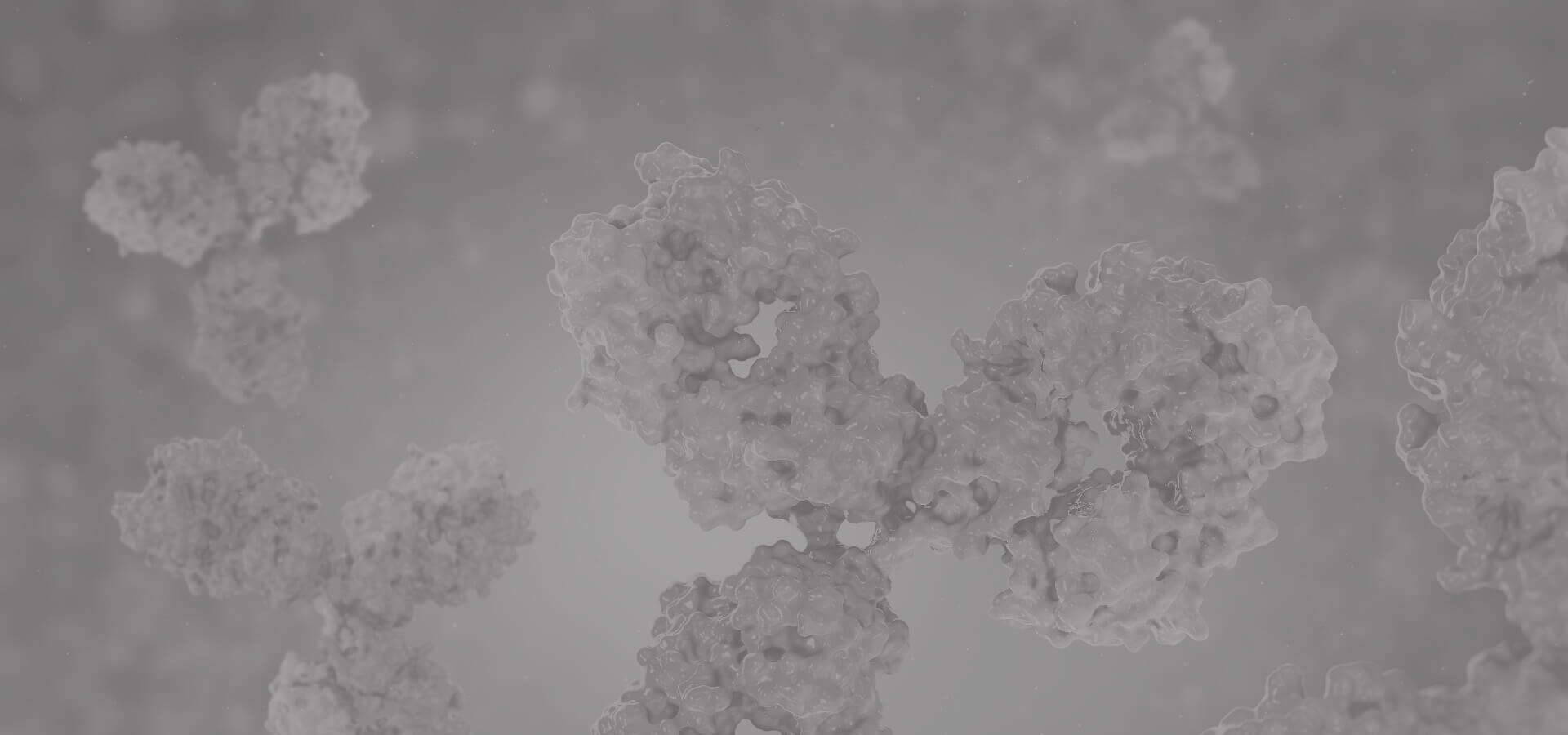CHRNA7
The nicotinic acetylcholine receptors (nAChRs) are members of a superfamily of ligand-gated ion channels that mediate fast signal transmission at synapses. The nAChRs are thought to be hetero-pentamers composed of homologous subunits. The proposed structure for each subunit is a conserved N-terminal extracellular domain followed by three conserved transmembrane domains, a variable cytoplasmic loop, a fourth conserved transmembrane domain, and a short C-terminal extracellular region. The protein encoded by this gene forms a homo-oligomeric channel, displays marked permeability to calcium ions and is a major component of brain nicotinic receptors that are blocked by, and highly sensitive to, alpha-bungarotoxin. Once this receptor binds acetylcholine, it undergoes an extensive change in conformation that affects all subunits and leads to opening of an ion-conducting channel across the plasma membrane. This gene is located in a region identified as a major susceptibility locus for juvenile myoclonic epilepsy and a chromosomal location involved in the genetic transmission of schizophrenia. An evolutionarily recent partial duplication event in this region results in a hybrid containing sequence from this gene and a novel FAM7A gene. Alternative splicing results in multiple transcript variants. [provided by RefSeq, Feb 2012]
Full Name
Cholinergic Receptor Nicotinic Alpha 7 Subunit
Function
After binding acetylcholine, the AChR responds by an extensive change in conformation that affects all subunits and leads to opening of an ion-conducting channel across the plasma membrane. The channel is blocked by alpha-bungarotoxin.
Biological Process
Acetylcholine receptor signaling pathway Source: ARUK-UCL
Activation of MAPK activity Source: UniProtKB
Calcium ion transport Source: UniProtKB
Cellular calcium ion homeostasis Source: UniProtKB
Chemical synaptic transmission Source: GO_Central
Cognition Source: UniProtKB
Dendrite arborization Source: ARUK-UCL
Dendritic spine organization Source: ARUK-UCL
Ion transmembrane transport Source: ParkinsonsUK-UCL
Ion transport Source: UniProtKB
Learning or memory Source: ARUK-UCL
Memory Source: ARUK-UCL
Modulation of excitatory postsynaptic potential Source: ARUK-UCL
Negative regulation of amyloid-beta formation Source: ARUK-UCL
Negative regulation of tumor necrosis factor production Source: MGI
Nervous system process Source: GO_Central
Positive regulation of amyloid-beta formation Source: ARUK-UCL
Positive regulation of angiogenesis Source: UniProtKB
Positive regulation of cell population proliferation Source: UniProtKB
Positive regulation of CoA-transferase activity Source: ARUK-UCL
Positive regulation of ERK1 and ERK2 cascade Source: ARUK-UCL
Positive regulation of excitatory postsynaptic potential Source: ARUK-UCL
Positive regulation of long-term synaptic potentiation Source: ARUK-UCL
Positive regulation of protein metabolic process Source: ARUK-UCL
Positive regulation of protein phosphorylation Source: ARUK-UCL
Regulation of amyloid fibril formation Source: ARUK-UCL
Regulation of amyloid precursor protein catabolic process Source: ARUK-UCL
Regulation of membrane potential Source: GO_Central
Regulation of neuron death Source: ARUK-UCL
Response to acetylcholine Source: ARUK-UCL
Response to amyloid-beta Source: ARUK-UCL
Response to hypoxia Source: UniProtKB
Response to nicotine Source: UniProtKB
Sensory processing Source: ARUK-UCL
Short-term memory Source: ARUK-UCL
Signal transduction Source: UniProtKB
Synapse organization Source: ARUK-UCL
Synaptic transmission, cholinergic Source: GO_Central
Activation of MAPK activity Source: UniProtKB
Calcium ion transport Source: UniProtKB
Cellular calcium ion homeostasis Source: UniProtKB
Chemical synaptic transmission Source: GO_Central
Cognition Source: UniProtKB
Dendrite arborization Source: ARUK-UCL
Dendritic spine organization Source: ARUK-UCL
Ion transmembrane transport Source: ParkinsonsUK-UCL
Ion transport Source: UniProtKB
Learning or memory Source: ARUK-UCL
Memory Source: ARUK-UCL
Modulation of excitatory postsynaptic potential Source: ARUK-UCL
Negative regulation of amyloid-beta formation Source: ARUK-UCL
Negative regulation of tumor necrosis factor production Source: MGI
Nervous system process Source: GO_Central
Positive regulation of amyloid-beta formation Source: ARUK-UCL
Positive regulation of angiogenesis Source: UniProtKB
Positive regulation of cell population proliferation Source: UniProtKB
Positive regulation of CoA-transferase activity Source: ARUK-UCL
Positive regulation of ERK1 and ERK2 cascade Source: ARUK-UCL
Positive regulation of excitatory postsynaptic potential Source: ARUK-UCL
Positive regulation of long-term synaptic potentiation Source: ARUK-UCL
Positive regulation of protein metabolic process Source: ARUK-UCL
Positive regulation of protein phosphorylation Source: ARUK-UCL
Regulation of amyloid fibril formation Source: ARUK-UCL
Regulation of amyloid precursor protein catabolic process Source: ARUK-UCL
Regulation of membrane potential Source: GO_Central
Regulation of neuron death Source: ARUK-UCL
Response to acetylcholine Source: ARUK-UCL
Response to amyloid-beta Source: ARUK-UCL
Response to hypoxia Source: UniProtKB
Response to nicotine Source: UniProtKB
Sensory processing Source: ARUK-UCL
Short-term memory Source: ARUK-UCL
Signal transduction Source: UniProtKB
Synapse organization Source: ARUK-UCL
Synaptic transmission, cholinergic Source: GO_Central
Cellular Location
Postsynaptic cell membrane; Cell membrane. TMEM35A/NACHO promotes its trafficking to the cell membrane (PubMed:27789755). RIC3 promotes its trafficking to the cell membrane (By similarity).
Topology
Extracellular: 23-230
Helical: 231-255
Helical: 262-280
Helical: 296-317
Cytoplasmic: 318-469
Helical: 470-490
Helical: 231-255
Helical: 262-280
Helical: 296-317
Cytoplasmic: 318-469
Helical: 470-490
PTM
Glycosylations at Asn-46, Asn-90 and Asn-133 are essential for TMEM35A/NACHO-mediated proper subunit assembly and trafficking to the cell membrane.
View more
Anti-CHRNA7 antibodies
+ Filters
 Loading...
Loading...
Target: CHRNA7
Host: Rat
Antibody Isotype: IgG1
Specificity: Rat, Chicken, Human, Mouse
Clone: CBWJN-1068
Application*: F, IF, WB, IP, P
Target: CHRNA7
Host: Mouse
Antibody Isotype: IgG1
Specificity: Human, Rat
Clone: CBWJN-1067
Application*: E, WB, F
Target: CHRNA7
Host: Mouse
Antibody Isotype: IgG1
Specificity: Human, Mouse
Clone: CBLNC-159
Application*: F, IF, WB, F, P
Target: CHRNA7
Host: Mouse
Antibody Isotype: IgG1
Specificity: Human, Rat
Clone: CBT3118
Application*: WB, F
Target: CHRNA7
Host: Mouse
Antibody Isotype: IgG1
Specificity: Human
Clone: CBT4265
Application*: IH, F
More Infomation
Hot products 
-
Mouse Anti-CD164 Recombinant Antibody (CBFYC-0077) (CBMAB-C0086-FY)

-
Mouse Anti-CCL18 Recombinant Antibody (64507) (CBMAB-C7910-LY)

-
Mouse Anti-ASTN1 Recombinant Antibody (H-9) (CBMAB-1154-CN)

-
Mouse Anti-CD33 Recombinant Antibody (6C5/2) (CBMAB-C8126-LY)

-
Mouse Anti-CFL1 (Phospho-Ser3) Recombinant Antibody (CBFYC-1770) (CBMAB-C1832-FY)

-
Rat Anti-CD63 Recombinant Antibody (7G4.2E8) (CBMAB-C8725-LY)

-
Rabbit Anti-ALK (Phosphorylated Y1278) Recombinant Antibody (D59G10) (PTM-CBMAB-0035YC)

-
Mouse Anti-CD46 Recombinant Antibody (CBFYC-0076) (CBMAB-C0085-FY)

-
Mouse Anti-EGR1 Recombinant Antibody (CBWJZ-100) (CBMAB-Z0289-WJ)

-
Mouse Anti-DMD Recombinant Antibody (D1190) (CBMAB-D1190-YC)

-
Mouse Anti-BLK Recombinant Antibody (CBYY-0618) (CBMAB-0621-YY)

-
Mouse Anti-EMP3 Recombinant Antibody (CBFYE-0100) (CBMAB-E0207-FY)

-
Mouse Anti-ATP1B1 Recombinant Antibody (E4) (CBMAB-0463-LY)

-
Rabbit Anti-AP2M1 (Phosphorylated T156) Recombinant Antibody (D4F3) (PTM-CBMAB-0610LY)

-
Mouse Anti-ATP5F1A Recombinant Antibody (51) (CBMAB-A4043-YC)

-
Mouse Anti-dsRNA Recombinant Antibody (2) (CBMAB-D1807-YC)

-
Rabbit Anti-Acetyl-Histone H3 (Lys36) Recombinant Antibody (V2-623395) (CBMAB-CP0994-LY)

-
Mouse Anti-AHCYL1 Recombinant Antibody (V2-180270) (CBMAB-A1703-YC)

-
Rat Anti-CD300A Recombinant Antibody (172224) (CBMAB-C0423-LY)

-
Rabbit Anti-ATF4 Recombinant Antibody (D4B8) (CBMAB-A3872-YC)

For Research Use Only. Not For Clinical Use.
(P): Predicted
* Abbreviations
- AActivation
- AGAgonist
- APApoptosis
- BBlocking
- BABioassay
- BIBioimaging
- CImmunohistochemistry-Frozen Sections
- CIChromatin Immunoprecipitation
- CTCytotoxicity
- CSCostimulation
- DDepletion
- DBDot Blot
- EELISA
- ECELISA(Cap)
- EDELISA(Det)
- ESELISpot
- EMElectron Microscopy
- FFlow Cytometry
- FNFunction Assay
- GSGel Supershift
- IInhibition
- IAEnzyme Immunoassay
- ICImmunocytochemistry
- IDImmunodiffusion
- IEImmunoelectrophoresis
- IFImmunofluorescence
- IGImmunochromatography
- IHImmunohistochemistry
- IMImmunomicroscopy
- IOImmunoassay
- IPImmunoprecipitation
- ISIntracellular Staining for Flow Cytometry
- LALuminex Assay
- LFLateral Flow Immunoassay
- MMicroarray
- MCMass Cytometry/CyTOF
- MDMeDIP
- MSElectrophoretic Mobility Shift Assay
- NNeutralization
- PImmunohistologyp-Paraffin Sections
- PAPeptide Array
- PEPeptide ELISA
- PLProximity Ligation Assay
- RRadioimmunoassay
- SStimulation
- SESandwich ELISA
- SHIn situ hybridization
- TCTissue Culture
- WBWestern Blot

Online Inquiry







